Where to Go in Namibia (2024)
Our 1-week itinerary
Wondering where to go in Namibia?
WHAT’S IN NAMIBIA?
So you’re wondering where to go in Namibia, huh? Well Namibia is a place full of vast landscapes that look straight out of a sci-fi movie, you’ll cruise through desolate deserts surrounded by sand dunes, get up to some wildlife shenanigans at Etosha National Park, and enjoy the pure freedom of the wide open roads. On top of that it’s very safe, and easily navigable by car—apart from the likelihood of a flat tire. We’ll give you our review of some of the top destinations, and help you plan where to go in your Namibian adventure.
WHAT TO EXPECT WHEN TRAVELING IN NAMIBIA
- You’ll need to rent a car to get around (depending where you’re from—be prepared to drive on the right side of the road) and you’ll spend a lot of time driving on gravel and dirt / sand roads.
- Namibia is not necessarily the cheapest destination. Renting a solid car for your whole trip and staying in travel lodges can get pricey.
- Because the country is so spread out and sparse, you’ll be driving a fair amount
- Get a local SIM card but don’t expect it to work well. We didn’t have much service when driving. Load your maps in advance!
IS ONE WEEK ENOUGH TO TRAVEL NAMIBIA?
There’s a lot to see and the driving distances are somewhat lengthy, but if you’re like us and want to squeeze in a 1-week trip, it’s totally possible, and we promise you can see plenty of unforgettable things. Nature lovers and those seeking less-touristed unique experiences will love Namibia as we did. Our 7-day Namibia self-drive road trip itinerary guide has got you covered with the things we learned, so that you can plan where to go to make the most of your trip to this epic country!
The Essential Tips for Traveling in Namibia:
- Be Prepared For Malaria.
If you’re traveling to northern Namibia, be aware it’s a malaria transmission area. We chose to use insect repellent instead of malaria pills, but make sure you figure out your plan in advance. - Do Not Skip on Car Insurance.
The roads are no joke. We didn’t feel unsafe, but the gravel roads are tough on your car. We had two flat tires and multiple windshield chips - Know How to Change a Tire.
Make sure you know how to change a tire and have all the necessary tools (car jack, spare tire) before hitting the road. - Handle Cash Wisely.
Avoid keeping all your cash in your wallet. We were stopped by police twice for minor infractions and pretty much asked to pay fines of whatever we had in our wallet. By keeping most of our cash hidden in the car, we managed to pay smaller amounts - Fuel Up Frequently.
There were some long driving stretches in Namibia without stations, so do yourself a favor and always fill up when you have the change. - You might not need 4WD.
We read a lot about needing 4WD in advance, but ended up with a mid-sized SUV without 4WD and we were totally fine. You’ll need 4WD if you want to drive the last leg to Deadvlei and avoid paying for a shuttle—but we would not recommend, as we saw even cars with 4WD get stuck and need to pay even more to get pulled out of the sand. So do your research, but if you’re getting 4WD just for Deadvlei as we almost did, consider skipping it and saving the money.

DAY 1: Waterberg Plateau
You can fly into Windhoek in the morning and drive straight from the airport (about 3.5 hours) to Waterberg Plateau. It’s a perfect location to break up the drive from Windhoek to Etosha National Park, and completely worth a stop in and of itself. The plateau is a long stretch of beautiful reddish rock jutting out above lush green landscape.

WHERE TO STAY IN WATERBERG PLATEAU
They have a variety of different lodges and campsites in the area. We stayed at Waterberg Wilderness. We had a little cabin situation with a porch overlooking the plateaus and it was insanely idyllic. They have breakfast and dinner buffets that may even be included in your accommodation price that were actually delicious.
THINGS TO DO IN WATERBERG PLATEAU
There’s several walks/hikes to do in the area, and you can of course hike up the plateau. There’s also the Cheetah Conservation center you can visit, some safari options, and a unique on-foot rhino tracking you can book through the lodge. Scary? Probably. We only had the afternoon, so we just sat on the porch playing cards, soaking up the scenery, and listening to baboons.

DAYS 2 – 4: Etosha National Park
This is the main attraction people visit during their time in Namibia, and it was well-worth the hype. What the landscape lacks in lush greenery it makes up for in pure animal activity. We had some of our coolest-ever animal encounters in Etosha. You can find zebra, several types of antelopes, hyenas, elephants, rhinos, giraffes, wildebeest, coyotes, lions, leopards, and cheetahs. Favorite moments had to be driving through a herd of zebra on the road, and tracking a herd of elephants and their babies, who eventually crossed the road right in front of us!
BEST TIME OF YEAR TO VISIT ETOSHA NATIONAL PARK
May through October is the dry season in Etosha, giving you a huge advantage in your wildlife-seeking endeavors, because all the animals have no choice but to flock to the few watering holes to drink up! You can conveniently pull up to the watering holes and just wait, and herds of animals will appear.
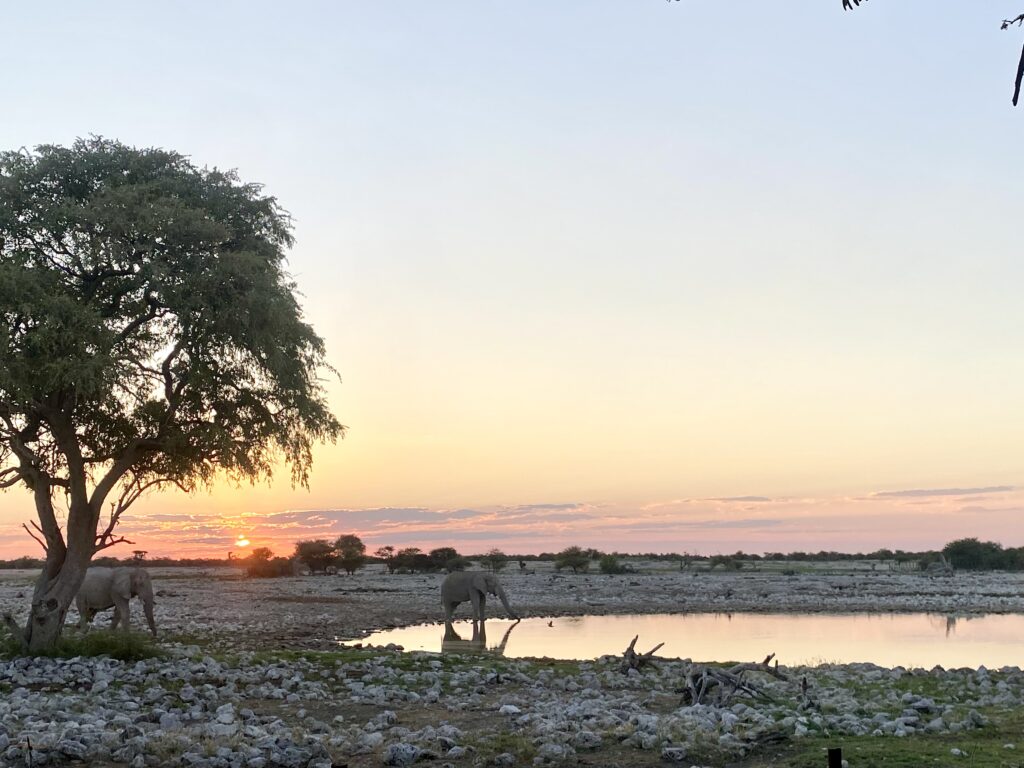
SELF-DRIVE, OR WITH A SAFARI GUIDE?
It’s pretty easy to book a safari through your accommodation once you’re there, so you can punt on the decision. If you have multiple days at Etosha, what we’d recommend is – drive yourself around on the first day, and then if you feel like you need more help to see the animals you want to see, book a safari for the next day. That was our plan, but we ended up having such a great time driving ourselves around, and saw so many animals without a guide, that we decided not to book a safari and save the money, as they can be a bit pricey. There are advantages to having a guide – they know the best places to be at the right times of day, and it seems like they notify one another when there’s a cool animal sighting (i.e. big cat) in the area, so you may be more likely to see the elusive animals.
WHERE TO GO IN ETOSHA PARK
The park is massive—it would take hours to get from one end to the other. But if you’re there in the dry season, you can target your route to visit the waterholes where the animals will inevitably be. The Etosha National Park website lists a number of watering holes and their more common animal visitors.
If you’re staying near the Okakuejo gate, the Okakuejo watering hole in the afternoon starting around 4PM was our favorite place to be. It’s right next to the campsite / chalets in the park, so it’s a less out in the wild, but you can bring some beers and sit on a bench, and watch the animals descend on the waterhole to have a drink and splash around. The variety of animal life is fun—you’ll catch some zebras and giraffes pulling up to have a drink alongside rhinos and elephants, and if you’re lucky some lions too (spoiler: you will likely not be so lucky and your only lion sightings will be of them sleeping, because that seems to be their favorite activity).

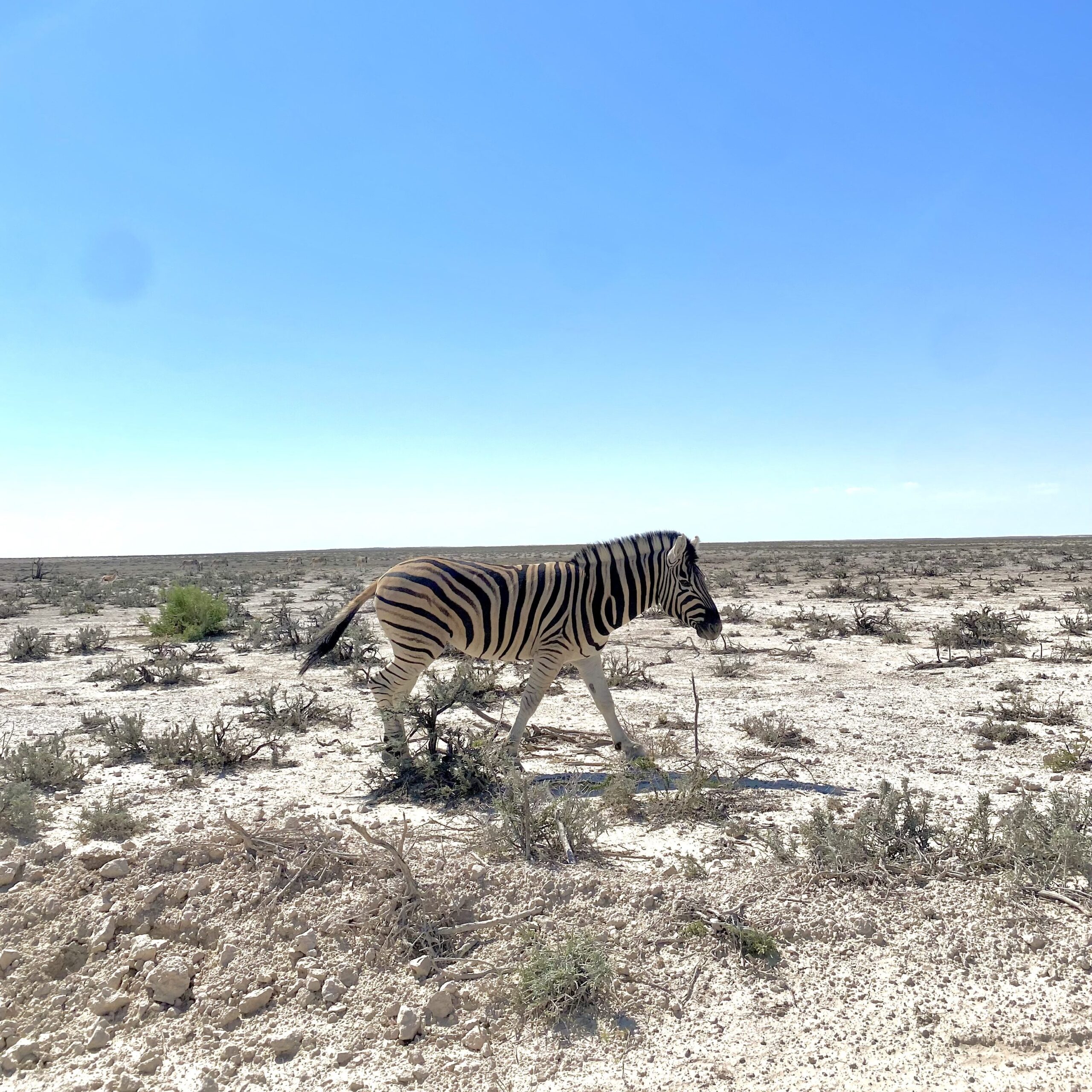

WHERE TO STAY IN ETOSHA PARK
We’ve heard mixed opinions here. Staying at the lodges / campsites at Okakuejo inside the park gives you access to the waterholes at all hours, and you can get an earlier start in the morning when the animals are active. If you’re not staying inside the park, you may have to sit in your car in a queue for a bit if you want to get into the park early, and you need to be out of the park by 6:30PM. We had to tear ourselves away from elephants at the watering hole at sunset to leave the park in time.
However, the general consensus is the lodges are nicer outside the park, and more affordable. Also important – the accommodation inside the park books up quickly, so you’ll need to book many months in advance for the busy seasons.
We weren’t able to get a spot in the park and stayed at Etosha Village, a short distance away. And it was niiiiice. Dinner & breakfast buffet were included, and boy do we love a buffet. Most lodges in the area will have a variety of game meats you can try – we had Kudu, Eland, Oryx, and Zebra. (A bit strange to go from photographing the animals to eating them for dinner… but try not to think about it too hard.)
GENERAL ETOSHA NATIONAL PARK TIPS
- Bring binoculars for big cat sightings, because they often refuse to come close to the road
- Bring some beers to the Okakuejo watering hole to watch from around 4PM through sunset to see the animals roll through
- If you catch the elephants at the Okakuejo watering hole, you can immediately leave the park and drive out towards the entrance stretch of road where they may cross, and you can get quite close up
- You should plan multiple days at the park – we didn’t see any elephants at all on the first day. You’ll wanna try your luck over a few days
- If you want to stay in the park, book early!


DAY 5 – 6: Swakopmund
Swakopmund is a little coastal town sandwiched between the Atlantic Ocean and the Namib desert. Driving along the coast, you’ll see ocean on one side, and sand dunes on the other. It’s known for its German colonial architecture and desert adventure activities. We were excited for the charming town we’d read about, but it didn’t quite live up to our expectations. We found it to be a bit underwhelming and industrial, and on our sunny day there, a massive black cloud of factory pollution was overhead. All of this of course comes with the caveat that every individual trip is unique, and depends quite a bit on the random experiences the universe throws at you. That being said, if we could adjust our itinerary with hindsight 20/20, we’d probably just spend one day in the area.
WHERE TO GO IN SWAKOPMUND
Walvis Bay—just 30 minutes below Swakopmund—is definitely worth a stop to see the flamingos that gather in numbers off its waterfront. It’s good wholesome fun to watch those goofy birds doing their thing


This is a great beer garden in Swakopmund called Alstadt Restaurant that’s a sweet space to hang, with tasty food. You can also do some desert activities like ATVing on dunes or desert tours.
Oh… and you may read about climbing up Dune 7. We read in some places that it’s one of the (or the?) highest dunes in Namibia… this is hard to believe after having seen the sand dunes in Sossusvlei (covered below). Dune 7 is in a fairly random location right off a highway. It was kinda hilarious to clamber up a dune on all fours, but be prepared it’s a full body workout and, and sand will blow in your every orifice at the top. The view from the top is not so nice, mostly freeway… So we’d say, if you’re eager to climb a dune and will be going to the Sossusvlei area, save it for then and skip Dune 7, especially if you have limited time in Swakopmund. Here are some photos of Dune 7 & the view, so you can make your call.
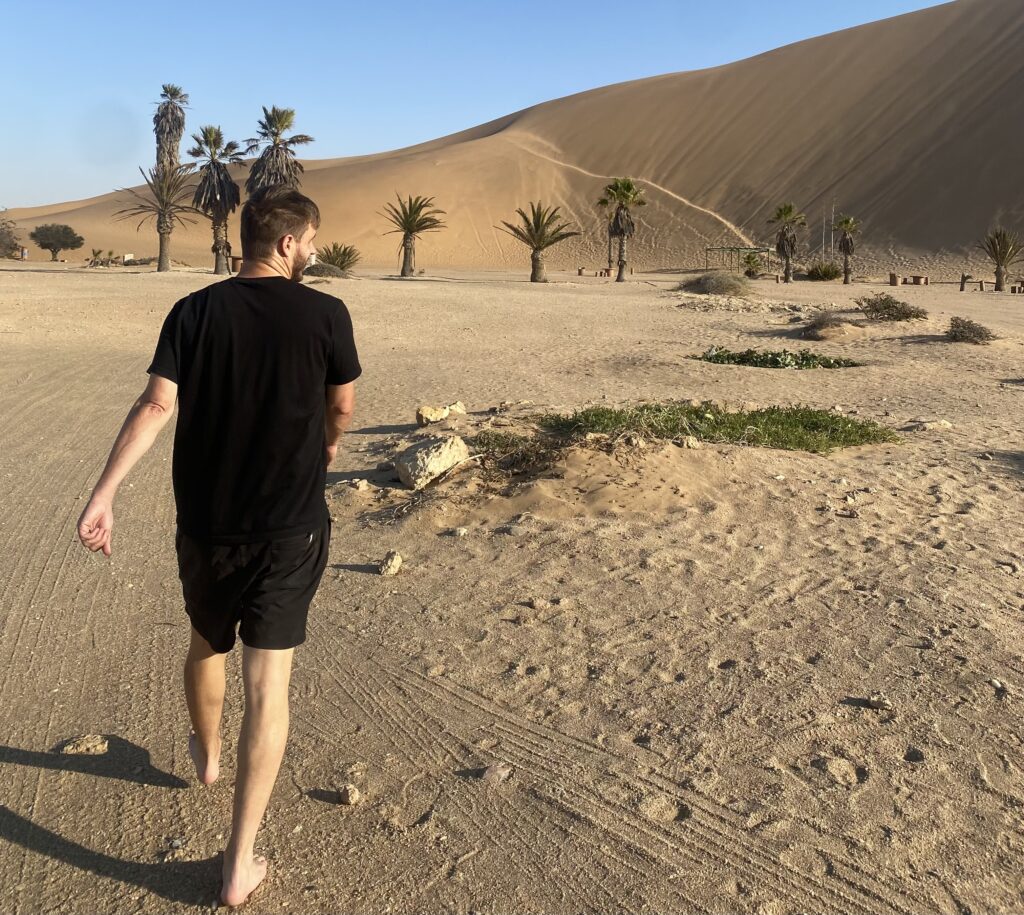

DAY 7: Sesriem (Sossusvlei / Deadvlei)
If there’s one place that truly captures the awe-inspiring beauty of Namibia, it’s Sossusvlei. Located within the Namib-Naukluft National Park, this region is home to some of the highest sand dunes in the world, including the iconic Big Daddy and Dune 45. The landscape is truly surreal, with towering red dunes contrasting sharply against the cracked white clay of Deadvlei, dotted with ancient, desiccated trees. Do not skip this.
DRIVING TO SESRIEM
The road get really gravel-y and sandy around here. This is where we had our first flat tire, and a chip in our windshield from a rock kicked up by an oncoming car. Cars in front of you will kick up clouds of grey dust that are impossible to see through, so keep your driving speed low.
Tip: Stop in the Solitaire funky little rest stop to fuel up, take some photos with cool rusty old cars if that suits you, and get a warm sausage roll & piece of freshly baked apple pie at the bakery.

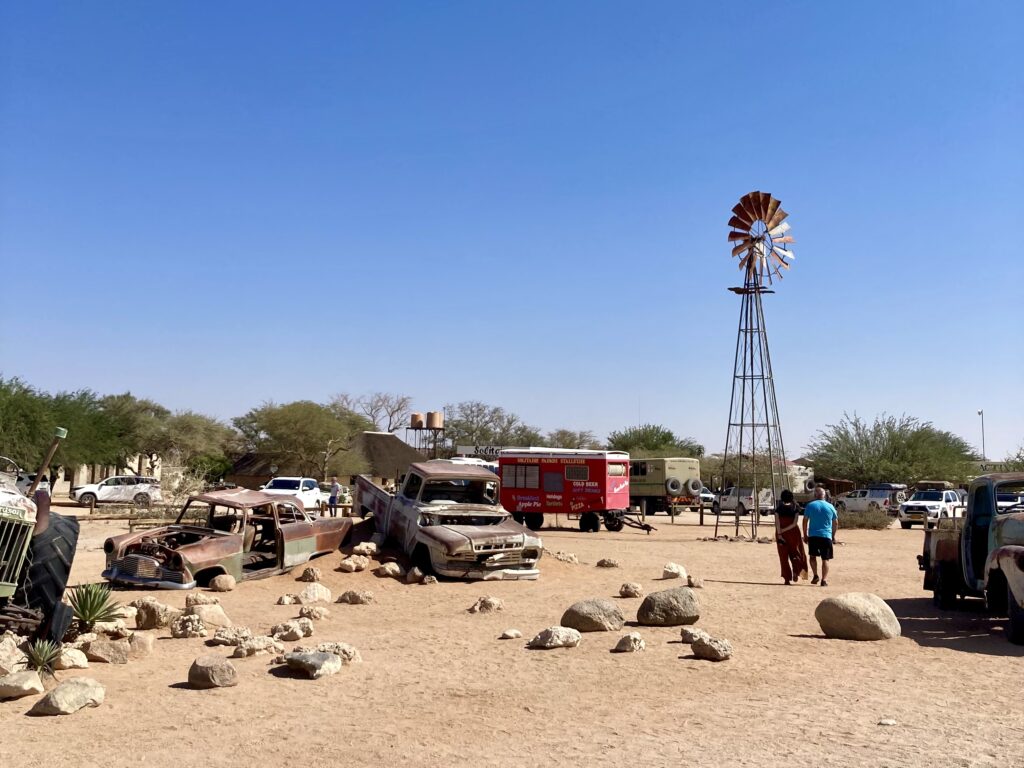
WHERE TO STAY IN SOSSUSVLEI
There’s plenty of lodges and campsites in the area. We stayed at Desert Quiver Camp, and were on a high when we pulled in and situated in our little cabin complete with outdoor kitchen, and views of rock formations and endless desert. You can dine at the (delicious) buffet at neighboring Sossusvlei Lodge, or they’ll bring marinated meats and sides to your room to grill out front of your cabin. Now a million pics of the camp because we’re obsessed.

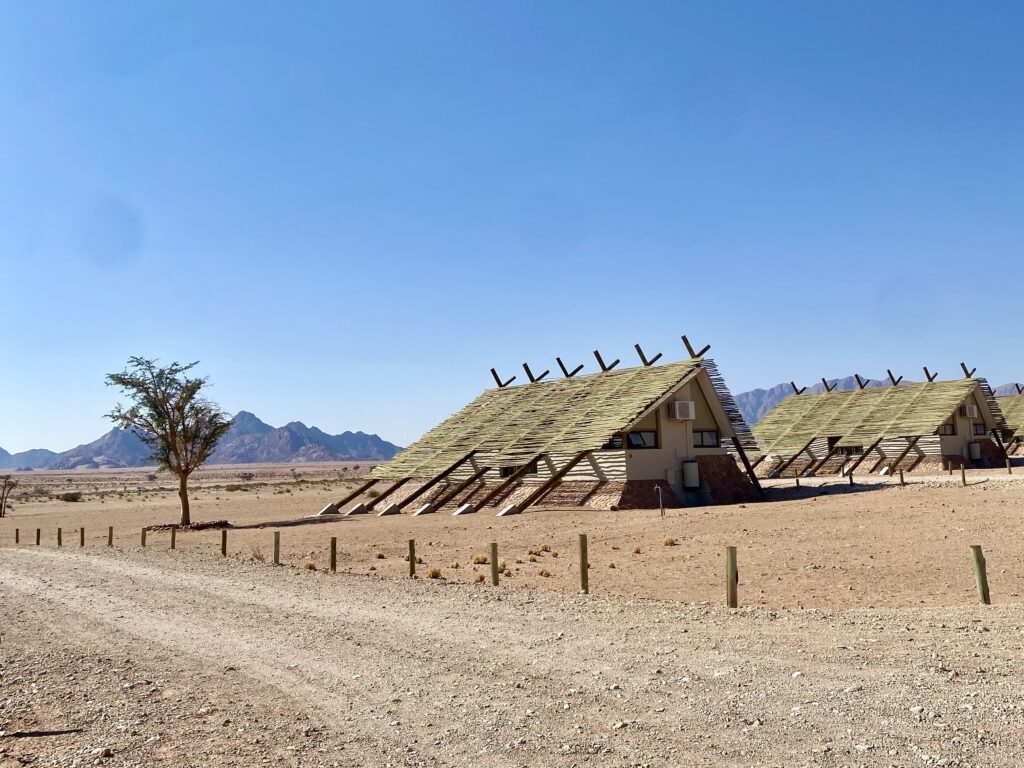
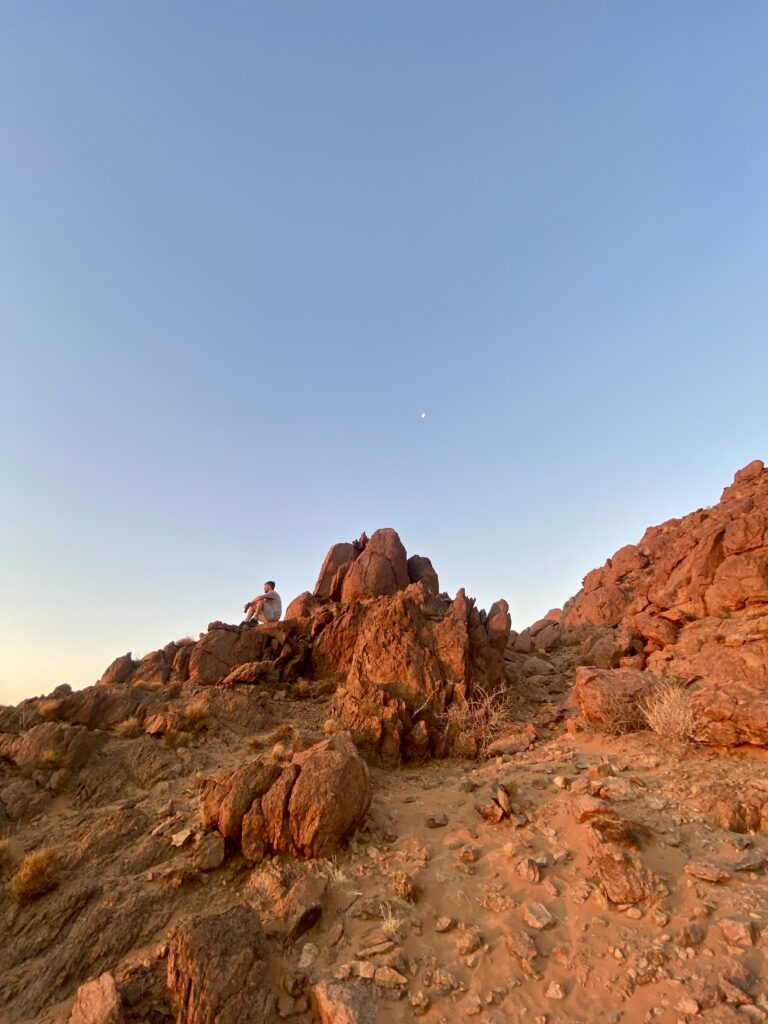
VISITING SOSSUSVLEI AND DEADVLEI
Get into Sossusvlei park early to have plenty of time for adventuring before it gets too hot. Plus the drive through the desert surrounded by sand dunes in the morning light was pretty darn breathtaking.
When you get to the parking lot for Sossusvlei & Deadvlei, even if you do have 4WD, you should probably suck it up and pay for the shuttle over. We saw no joke 5 different cars (all with 4WD) stuck in the sand on the drive over, and they had to pay a chunk of cash to get rescued.
HIKING OPTIONS TO DEADVLEI:
- If you want to climb Big Daddy Dune—the tallest dune in the area overlooking Deadvlei—from the shuttle drop-off point you can make your way up and up the winding crests of the dune to the final peak. Once you make it to the top, you’re rewarded by getting to run down the side of the dune into Deadvlei valley, which feels like you’re running on the moon. The views are epic.
- If you want to shorten the Big Daddy Dune walk a bit, you can get dropped off at the “shortcut” spot (ask the shuttle driver). We took this route and were still thoroughly exhausted (It is not easy to walk up the crests of dunes, just so ya know). We even abandoned early, down the side of the dune into the valley.
- You can skip the Big Daddy hike altogether and go on a short sandy walk at the end of the shuttle ride straight into Deadvlei.



Descending on Deadvlei with the cracked earth and gnarled trees surrounded by dunes feels like an otherworldly place. We reckon it’s one of the coolest landscapes we’ve ever seen.


Conclusion
Namibia’s chock-full of things to see. Whether you’re drawn to the vast deserts, diverse wildlife, or simply the open road, Namibia doesn’t disappoint. We hope our guide has given you useful tips and insights for your own journey through this incredible country. Prepare for some rugged roads, and get ready to explore one of Africa’s most captivating places. Safe travels!